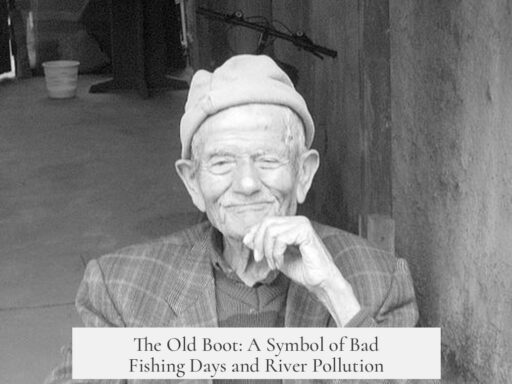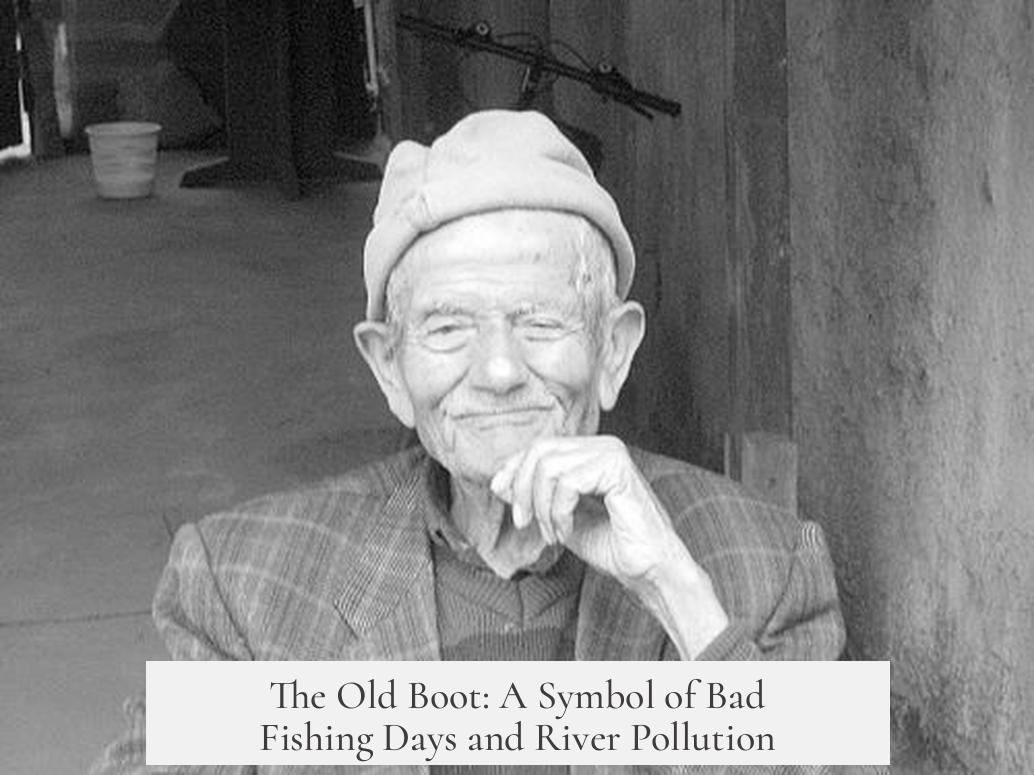An old boot became the stereotypical “rubbish” pulled up on a bad day of fishing due to a mix of cultural stories, common pollution practices, and the physical durability of boots in water. People in the 19th and 20th centuries frequently discarded old shoes and boots into rivers, making such finds a familiar, frustrating outcome for fishermen.

The trope of hauling up an old boot instead of a fish has roots in folklore. An early example appears in the Arabic tale “The Slippers of Abū al-Qāsim al-Tanbūrī.” In this story, a fisherman mistakenly pulls up slippers that damage his net. The slippers belong to a miser, and the fisherman throws them back through his window, damaging prized objects. This popular tale, often linked to the “One Thousand and One Nights” collection, likely shaped Western perceptions of unlucky fishing encounters. Though it may not be the sole source, it contributed to the cultural image of unwanted footwear in fishing nets.
In addition to narrative origins, historical pollution heavily supports why old boots became common catch. During the 19th and 20th centuries, communities paid little attention to environmental protection. Rivers often became dumping grounds for household refuse, including worn-out shoes. Charles George Harper, a writer from the early 1900s, described rivers cluttered with tin cans, old boots, broken glass, crockery, and fish offal. He lamented the many types of unwanted waste polluting waterways, naming the “old boot” as the most frequent object found across shores, paths, and ditches.

Disposing of footwear into rivers was common. Urban and rural areas alike saw boots and shoes tossed into streams, partly because durable leather items resisted quick decay. Boots would soak in wet places and remain largely intact. Archaeological finds support this: during excavations in Copenhagen for a metro line, researchers uncovered about 7,000 leather artifacts dating from the 1300s to 1800s, with more than 4,000 being footwear items. Such discoveries show how prevalent and long-lasting discarded boots have been in wet environments.
Mudlarks—people who scour riverbanks—regularly find old leather shoes along the Thames, further confirming how many boots ended up in waterways. The materials and anaerobic soil conditions allowed leather footwear to survive over centuries, which is why they are frequently uncovered and continue to appear in popular imagination as the quintessential unwanted catch.

This history also links to humorous cultural references. For example, an 1892 joke humorously tells of a fisherman who, despite knowing fish species by bite, pulls up an old boot instead of a fish. Visual art and postcards from the late 19th century often depicted the scene of frustrated fishermen reeling in boots, showing it was a familiar and relatable scenario by then.
Concisely, the presence of old boots in fishing nets came from:

- Folklore that embedded the image as a symbol of bad luck in fishing.
- Common 19th- and 20th-century habits of throwing worn footwear into rivers.
- The durability and preservation qualities of leather boots in wet conditions.
- Cultural reinforcement through jokes, art, and literature depicting boots as typical “trash” caught on bad days.
| Aspect | Explanation |
|---|---|
| Folklore Origin | Arabic tale of slippers influencing Western trope of unlucky fishing |
| Pollution Practice | 19th/20th-century dumping of boots into waterways common |
| Archaeological Evidence | Thousands of preserved boots found in wet sites attest to abundance |
| Cultural Reinforcement | Jokes, postcards, and paintings popularized the image of boots as unwanted catch |
The question of whether many people threw boots into rivers at that time is answered affirmatively. Historical accounts and archaeological finds confirm widespread disposal of footwear in watercourses. The durability of leather ensured these boots survived long enough to become typical “catches” on poor fishing days. This reality fused with traditional stories to create a lasting stereotype.
- The old boot symbolizes failure and bad luck in fishing due to cultural and environmental reasons.
- Pollution of rivers with boots was widespread in the 19th and 20th centuries.
- Leather boots’ preservation in water and mud made them a common archaeological find.
- Folktales, humor, and visual arts helped cement the old boot as a fishing cliché.
Why Is an Old Boot the Classic “Rubbish” Pulled Up on a Bad Fishing Day?

It boils down to history, folklore, and a hefty dose of real-life river pollution. Old boots didn’t magically multiply in waterways — they were quite literally discarded by people less mindful of their environment, and centuries of stories made them symbolic of fishing misfortune.
You ever wonder why every joke about a rotten day fishing has an old boot involved? It’s not just coincidence or random imagination. There’s an intriguing tapestry behind this cliché, blending ancient storytelling and the messy realities of 19th- and 20th-century Western river life.

Fishermen’s Old Boot—A Tale as Old as Time
Believe it or not, the idea of pulling up an old shoe or boot when fishing badly can be traced back to a classic Arabic folktale: The Slippers of Abū al-Qāsim al-Tanbūrī. In the story, a fisherman accidentally drags slippers from his net — a mistake that causes trouble because their nails tear his net. Frustrated, he throws them back through a miser’s window, landing on precious objects and causing chaos.
This tale has been popular and circulated widely, often included in collections alongside the famous One Thousand and One Nights. Whether or not it inspired the fishing trope, it certainly helped cement the idea of the unlucky fisherman pulling up footwear instead of fish.
So, this old boot concept isn’t just Western folklore; it crosses cultures and histories, mixing storytelling with everyday frustrations.
Worse Than the Usual Catch: Pollution in Rivers and Streams
Now, let’s talk facts: real boots in real rivers. The 19th and early 20th centuries didn’t exactly mark the birth of environmental consciousness. People dumped garbage into rivers like it was an afterthought, and shoes—old boots included—were common trash.
What’s that you say? You never thought there were THAT many boots flung into waterways? Well, digging up riverbeds has uncovered surprises like old shoes, small boats, knives, and even a surprising number of “woman’s buns”—no, not bread! A hairstyle, apparently.
One well-known rant from Charles George Harper captures this vividly: “I prefer paintings to photos, because reality shows battered tin cans, broken crockery, fish offal, old boots, and other unpicturesque rubbish cast into the water by lazy housewives.” His colorful commentary underlines just how common these objects were.
Boots were the “commonest object,” whether at shorelines, highways, or ditches. No terrain was too remote for discarded footwear to show up. So yes, people literally threw many boots into rivers, giving rise to the realism behind the old boot trope in fishing tales.
Humor and Anecdotes That Keep the Trope Alive
It didn’t stop at just stories and real pollution. Jokes and witty tales helped keep the old boot trope alive in people’s minds. There’s the story of Cecil Roberts who once pulled up a right-foot boot while fishing and, finding it a better fit, humorously swapped it for his own boot. That’s not something you hear every day.
Back in 1892, an old fisherman bragged about how he recognition fish species by their bite only to haul up an old boot instead. This punchline plays on the relatable disappointment of catching “rubbish” instead of actual fish, an experience many anglers know well.
Visual Culture and the Old Boot
The trope also dominated visual humor. An 1880 ornamental taxidermy piece showed a fisherman pulling a “big fish” — only for it to be an old shoe. A mechanical window-piece from 1887 portrayed a lone fisherman undeterred after snagging old boots amid many failed attempts. These images circulated widely as postcards and prints, cementing the trope in popular culture.
Archaeological Evidence: We’ve Actually Found Thousands of Boots
Now, here’s a neat fact: leather footwear preserves exceptionally well in wet conditions due to anaerobic soils that slow decay. Archaeologists excavating urban and wetland sites find leather shoes more often than you might think.
For example, during metro-ring construction in Copenhagen, nearly 7,000 leather artefacts turned up, including around 4,000 shoes and boots dating from the 1300s to the 1800s. Imagine that—a historic riverbed or city area loaded with centuries-old footwear!
Mudlarkers on the Thames still find new and old leather shoes regularly. These hobbyists scour river shores and confirm that shoes and boots are among the most common artefacts found in river sediments.
So, Were People Actually Throwing Boots into Rivers in Large Numbers?
In short, yes. The prevalence of discarded footwear in rivers, combined with long-standing cultural references in tales and humor, explains why the old boot is the stereotypical “rubbish” pulled up on bad fishing days.
People routinely discarded unwanted goods, including boots, into waterways. Over time, this practice became a shared symbol of fishing disappointment and misfortune.
What Can Modern Anglers Learn From This?
- Don’t throw your old boots in the river, please.
- Appreciate the history behind the quirky fishing trope—it’s a reminder of past human habits.
- Consider how pollution impacts ecosystems—those old boots once harmed fishing just as trash does today.
- Share the story with fellow anglers when pulling up a boot, or better yet, an actual fish.
Next time your line tugs and you haul up a soggy boot, you’re holding millennia of history, pollution realities, and a bit of folklore that’s swum through centuries of human misadventure.
Fishing for fish, but catching history—who knew an old boot could tell such a rich story?




